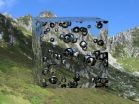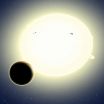Mutations need help from aging tissue to cause leukemia
2014-12-18
(Press-News.org) Why are older people at higher risk for developing cancer? Prevailing opinion holds that, over time, your body's cells accumulate DNA damage and that eventually this damage catches up with the body in a way that causes cancer. A University of Colorado Cancer Center study published today in the journal Aging shows that this prevailing opinion is incomplete. In addition to DNA damage, cancer depends on the slow degradation of tissue that surrounds cancer cells, something that naturally comes with aging.
"It's really all about natural selection and survival of the fittest," says James DeGregori, PhD, investigator at the CU Cancer Center, professor of Biochemistry and Molecular Genetics at the CU School of Medicine, and the paper's senior author.
"When you're young, healthy cells are optimized to the surrounding tissue - they're the 'fittest'," DeGregori says. "At that point, any mutation that affects function makes a cell less fit, so cells with mutations, even cancer-causing mutations, are out-competed by the young, fit, healthy cells. But when the tissue landscape changes with aging, healthy cells may no longer be optimized to their surroundings. In this aged landscape, mutations may actually make certain cells better, allowing them to out-compete the normal cells and form tumors. That's why older people get cancer."
Working in the DeGregori Lab, postdoc and first author Andrii Rozhok, PhD, created mathematical models of just this kind of natural selection in hematopoietic or blood cells. Like predicting the weather, Rozhok combined several variables into a model and then asked how well the model could predict what we see in the real world. For example, in the case of weather, accurately taking into account barometric pressure and the calendar day could predict a snowstorm. Similarly, if you were to believe prevailing opinion, you'd say that mutation accumulation would predict leukemia development. When Rozhok plugged only mutation variables into his model, however, there was poor fit. That is to say, the model could not accurately predict stem cell changes over time or leukemia development.
"We knew mutations would play a role, perhaps even a big role, but it became clear there was something else going on. We had been looking inside cells for the causes of cancer, but that wasn't enough. There was something happening outside the cells that mattered, and that something is what allows cancer to form," DeGregori says.
Rozhok and colleagues then added more variables to the model to account for microenvironmental tissue decline. Suddenly, there was a much better fit. The new model, driven by age-related changes in stem cell fitness and behavior, accurately predicts the point at which a cancer cell might out-compete the normal cells and become a leukemia. Importantly, the model demonstrates that the systemic processes accompanying general tissue decline with age have a crucial power in governing cancer cell fates and the odds of developing cancer.
"We'd always thought the tissue landscape was important, but we didn't know how important," DeGregori says. He points out that natural selection only "cares" about the human body until it passes reproductive age. "We have programmed maintenance that takes care of our bodies and keeps us fit until around age 40. At that point, our maintenance program gets lazy. Our tissue landscape starts to change, and unfortunately it changes in ways that allow cancer cells to out-compete normal cells."
In all, "We show that mutations, although necessary, cannot promote blood cancer development without an age-altered tissue microenvironment," the researchers write.
"This implies that in addition to research and drug development aimed at the genetic mutations associated with cancer, we need to work on maintaining the fitness of our tissue landscape in order to prevent cancer cells from taking over. Natural selection has provided us with a very effective mechanism to accomplish this maintenance until middle age; what comes after may be up to us," DeGregori says.
# END
ELSE PRESS RELEASES FROM THIS DATE:
2014-12-18
Illinois is the most critical hub in the network of U.S. domestic food transfers, according to a new study by Megan Konar, an assistant professor of civil and environmental engineering, and colleagues at the University of Illinois at Urbana-Champaign. The study was published in the journal Environmental Science and Technology.
Much like the national airport network in which O'Hare International Airport is a major hub, Illinois plays the most central role in distributing food across the U.S. According to the report, the U.S. food network moves more than 400 million tons ...
2014-12-18
Doctors and nurses are traditionally thought to be the primary caretakers of patients in a typical hospital setting. But according to a study at the burn center intensive care unit at Loyola University Health System, three physicians, a social worker and a dietitian were documented as the most central communicators of the patient clinical team.
David Shoham, PhD, and colleagues were published in the American Burn Association's Journal of Burn Care & Research. Shoham is an associate professor in the Department of Public Health Sciences of Loyola University Chicago Stritch ...
2014-12-18
Chicago, December 17, 2014--A poll of the Russian public, conducted by The Associated Press-NORC Center for Public Affairs Research, was released today. The poll, which includes a nationally representative in-person survey of 2,008 Russian adults taken between November 22 and December 7, 2014, found that President Vladimir Putin is extremely popular. Few say the economy is in good condition and most say that sanctions are hurting the Russian economy. Despite economic woes, most Russians believe their country is headed in the right direction. Most respondents are also optimistic ...
2014-12-18
WASHINGTON, D.C., December 18, 2014 -- Uncork a bottle of champagne, and as the pressure of the liquid is abruptly removed, bubbles immediately form and then rapidly begin the process of "coarsening," in which larger bubbles grow at the expense of smaller ones.
This fundamental nonequilibrium phenomenon is known as "Ostwald ripening," and though it is most familiar for its role in bubbly beverages, it is also seen in a wide range of scientific systems including spin systems, foams and metallic alloys.
On a much larger scale, Ostwald ripening can be observed in a power-generating ...
2014-12-18
Cilia, the cell's tails and antennas, are among the most important biological structures. They line our windpipe and sweep away all the junk we inhale; they help us see, smell and reproduce. When a mutation disrupts the function or structure of cilia, the effects on the human body are devastating and sometimes lethal.
The challenge in diagnosing, studying and treating these genetic disorders, called ciliopathies, is the small size of cilia -- about 500-times thinner than a piece of paper. It's been difficult to examine them in molecular detail until now.
Professor ...
2014-12-18
COLUMBIA, Mo. - A new study from University of Missouri and Virginia Tech researchers is challenging accepted ideas about how ancient soft-bodied organisms become part of the fossil record. Findings suggest that bacteria involved in the decay of those organisms play an active role in how fossils are formed--often in a matter of just a few tens to hundreds of years. Understanding the relationship between decay and fossilization will inform future study and help researchers interpret fossils in a new way.
"The vast majority of the fossil record is composed of bones and ...
2014-12-18
New Rochelle, NY, December 18, 2014--Internet addiction is an impulse-control problem marked by an inability to inhibit Internet use, which can adversely affect a person's life, including their health and interpersonal relationships. The prevalence of Internet addiction varies among regions around the world, as shown by data from more than 89,000 individuals in 31 countries analyzed for a study published in Cyberpsychology, Behavior, and Social Networking, a peer-reviewed journal from Mary Ann Liebert, Inc., publishers. The article is available free on the Cyberpsychology, ...
2014-12-18
Health care systems and providers are not attuned to older adults' malnutrition risk, and ignoring malnutrition exacts a toll on hospitals, patients, and payers, according to the latest issue of the What's Hot newsletter from The Gerontological Society of America (GSA).
Under the title "Aging Policy: Preventing and Treating Malnutrition to Improve Health and Reduce Costs," the new installment points out that aging is a risk factor for malnutrition and highlights opportunities to improve nutrition awareness, interventions, and policy priorities.
Support for the publication ...
2014-12-18
To paraphrase Mark Twain, the report of the Kepler spacecraft's death was greatly exaggerated. Despite a malfunction that ended its primary mission in May 2013, Kepler is still alive and working. The evidence comes from the discovery of a new super-Earth using data collected during Kepler's "second life."
"Like a phoenix rising from the ashes, Kepler has been reborn and is continuing to make discoveries. Even better, the planet it found is ripe for follow-up studies," says lead author Andrew Vanderburg of the Harvard-Smithsonian Center for Astrophysics (CfA).
NASA's ...
2014-12-18
New Rochelle, NY, December 18, 2014--Pretreatment of cellulosic biomass using cell wall degrading enzymes is a critical step in the release of sugars needed to produce biofuels and renewable, biobased chemicals and materials. A new study that demonstrates and quantifies the impact of enzymatic hydrolysis and drying on the nanostructure and available reaction volume of pretreated hardwoods and switchgrass is published in Industrial Biotechnology, a peer-reviewed journal from Mary Ann Liebert, Inc., publishers. The article is available on the Industrial Biotechnology website ...
LAST 30 PRESS RELEASES:
[Press-News.org] Mutations need help from aging tissue to cause leukemia




